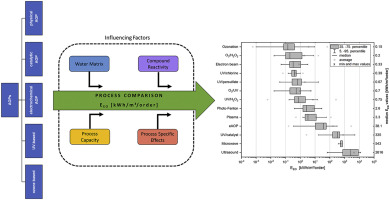Water Research ( IF 11.4 ) Pub Date : 2018-03-22 , DOI: 10.1016/j.watres.2018.03.042 David B. Miklos , Christian Remy , Martin Jekel , Karl G. Linden , Jörg E. Drewes , Uwe Hübner

|
This study provides an overview of established processes as well as recent progress in emerging technologies for advanced oxidation processes (AOPs). In addition to a discussion of major reaction mechanisms and formation of by-products, data on energy efficiency were collected in an extensive analysis of studies reported in the peer-reviewed literature enabling a critical comparison of various established and emerging AOPs based on electrical energy per order (EEO) values. Despite strong variations within reviewed EEO values, significant differences could be observed between three groups of AOPs: (1) O3 (often considered as AOP-like process), O3/H2O2, O3/UV, UV/H2O2, UV/persulfate, UV/chlorine, and electron beam represent median EEO values of <1 kWh/m3, while median energy consumption by (2) photo-Fenton, plasma, and electrolytic AOPs were significantly higher (EEO values in the range of 1–100 kWh/m3). (3) UV-based photocatalysis, ultrasound, and microwave-based AOPs are characterized by median values of >100 kWh/m3 and were therefore considered as not (yet) energy efficient AOPs. Specific evaluation of 147 data points for the UV/H2O2 process revealed strong effects of operational conditions on reported EEO values. Besides water type and quality, a major influence was observed for process capacity (lab-vs. pilot-vs. full-scale applications) and, in case of UV-based processes, of the lamp type. However, due to the contribution of other factors, correlation of EEO values with specific water quality parameters such as UV absorbance and dissolved organic carbon were not substantial. Also, correlations between EEO and compound reactivity with OH-radicals were not significant (photolytically active compounds were not considered). Based on these findings, recommendations regarding the use of the EEO concept, including the upscaling of laboratory results, were derived.
中文翻译:

评价用于水和废水处理的高级氧化工艺–严格审查
这项研究概述了已建立的工艺以及用于高级氧化工艺(AOP)的新兴技术的最新进展。除了讨论主要的反应机理和副产物的形成外,还通过对同行评审文献中报道的研究的广泛分析,收集了能效数据,从而可以根据每单位电能对各种既定和新兴的AOP进行关键比较。阶(E EO)值。尽管所查看的E EO值存在很大差异,但在三组AOP之间可以观察到显着差异:(1)O 3(通常被视为类AOP过程),O 3 / H 2 O 2,O 3/ UV,UV / H 2 O 2,UV /过硫酸盐,UV /氯和电子束表示中值E EO值<1 kWh / m 3,而中值能耗由(2)光芬顿,等离子体和电解产生AOP明显更高(E EO值在1-100 kWh / m 3的范围内)。(3)基于紫外线的光催化,基于超声和基于微波的AOP的特征在于中值> 100 kWh / m 3,因此被认为(尚未)具有能源效率。对UV / H 2 O 2工艺的147个数据点的具体评估表明,操作条件对所报告的E EO具有很强的影响价值观。除了水的类型和质量以外,还观察到了对处理能力(实验室与实验与大型应用之间)和灯类型的主要影响(在基于UV的方法中)。但是,由于其他因素的影响,E EO值与特定水质参数(如UV吸收率和溶解的有机碳)之间的相关性并不明显。同样,E EO与化合物与OH自由基的反应性之间的相关性也不显着(未考虑光解活性化合物)。基于这些发现,得出了有关使用E EO概念的建议,包括扩大实验室结果。










































 京公网安备 11010802027423号
京公网安备 11010802027423号